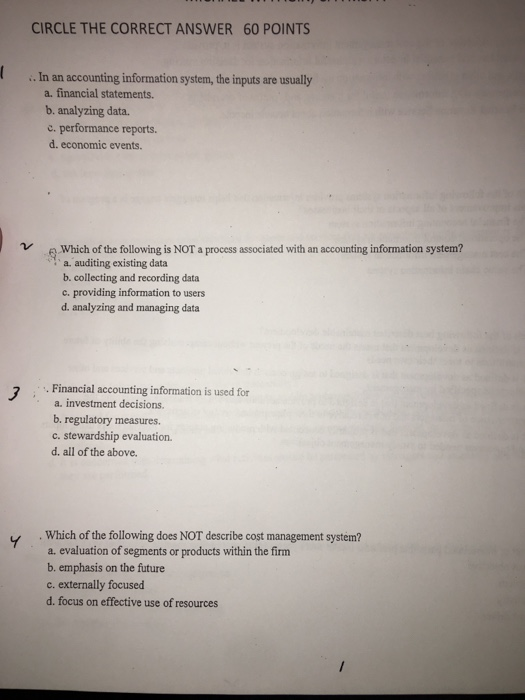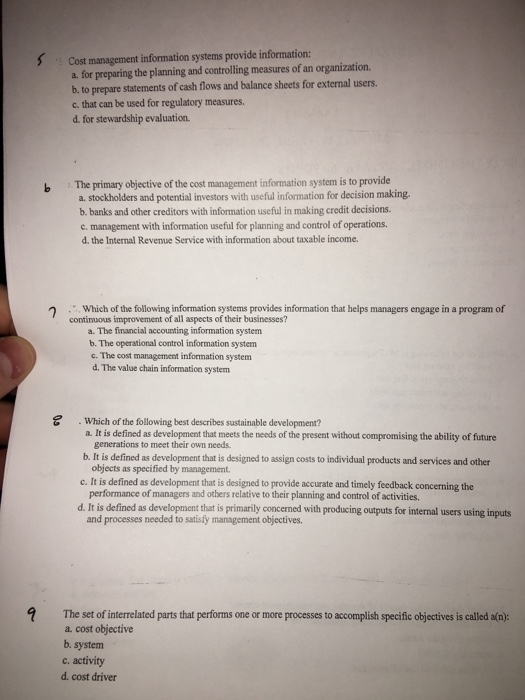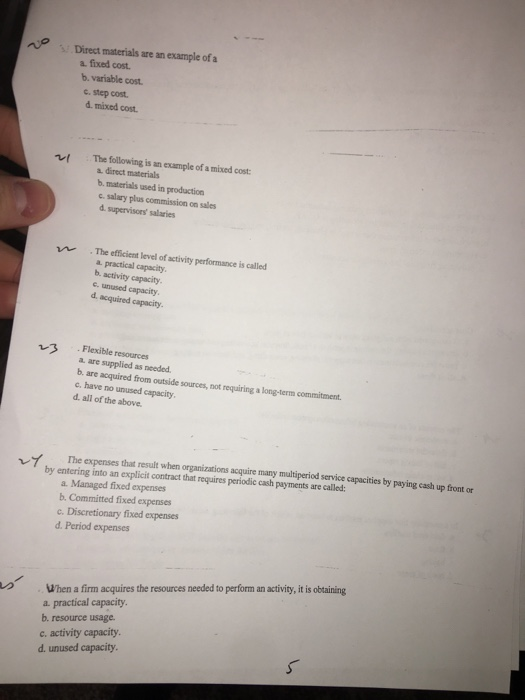CIRCLE THE CORRECT ANSWER 60 POINTS .. In an accounting information system, the inputs are usually a. financial statements. b. analyzing data. c. performance reports d. economic events. eWhich of the following is NOT a process associated with an accounting information system? a. auditing existing data b. collecting and recording data c. providing information to users d. analyzing and managing data Financial accounting information is used for a. investment decisions. b. regulatory measures. c. stewardship evaluation. d. all of the above. y 'which ofthe following does NOT describe cost management system? a. evaluation of segments or products within the firm b. emphasis on the future c. externally focused d. focus on effective use of resources SCost management information systems provide information: a. for preparing the planning and controlling measures of an organization. b. to prepare statements of cash flows and balance sheets for external users c. that can be used for regulatory measures. d. for stewardship evaluation. b The primary objective of the cost management information system is to provide a. stockholders and potential investors with useful information for decision making. b. banks and other creditors with information useful in making credit decisions. c. management with information useful for planning and control of operations. d. the Internal Revenue Service with information about taxable income. Which of the following information systems provides information that helps managers engage in a program of continuous improvement of all aspects of their businesses? a. The financial accounting information system b. The operational control information system c. The cost management information system d. The value chain information system 2 .Which of the following best describes sustainable development? a. It is defined as development that meets the needs of the present without compromising the ability of future generations to meet their own needs b. It is defined as development that is designed to assign costs to individual products and services and other c. It is defined as development that is designed to provide accurate and timely feedback concerning the d. It is defined as development that is primarily concerned with producing outputs for internal users using inputs objects as specified by management. performance of managers and others relative to their planning and control of activities. and processes needed to satisfy management objectives. 2 The set of interrelated parts that performs one or more processes to accomplish specific objectives is called a(n): a. cost objective b. system c activity d. cost driver Which of the and othech of the following is a cost management subsystem designed to assign costs to individual products and services aheobjcs, a specified by management? a. financial accounting information system operational control information system c. cost accounting information system d. all of the above managers management suboystem designed to provide accurate and timely feedhack concerning the performane of managers and others relative to their planning and control activities is called the: a. cost accounting information system b. financial accounting system C. operational control information system d. tax reporting system The cash or cash equivalent value sacrificed for goods and services that are expected to bring a current or future benefit to the organization is/are called a. Expenses b. Cost c. An activity d. A loss 3Which of the following statements is true of traceability? well-specified economic events as inputs, and its processes follow certain rules and conventions a. It uses b. It is used for investment decisions, stewardship evaluation, activity monitoring, and regulatory measures. c. It is the ability to assign a cost directly to a cost object in an economically feasible way by means of a causal relationship. with determining what activities should be performed by managers and assessing how well d. It is concerned they are performed. h of the following costs incurred by a chair manufacturer would be traced to the product cost through direct tracing? a. the depreciation on factory equipment b. the supervisor's salary c. the insurance on the factory building d. the woodworker's salary Which of the following costs is an example of product costs? a. selling commissions b. nonfactory office salaries c. direct materials d. advertising expense Conversion costs do NOT include a. direct materials b. direct labor. c. factory overhead. d. any of these costs. inrodaced change are clle a. Non-unit-level drivers b. Activity based cost drivers c. Unit-level drivers d. All of these . Rent of S10,000 paid per month for renting a building is an example of s(m): a. fixed cost. b. variable cost. c. opportunity cost. d. marginal cost A manufacturing company pays an assembly line worker $12 per hour. What is the proper classification of this labor cost? a. variable cost b. semivariable cost c. fixed cost d. mixed cost Direct materials are an example of a a fixed cost b. variable cost c. step cost d. mixed cost. The following is an example of a mixed cost a direct materials b. materials used in production salary plus commission on sales d. supervisors' salaries The efficient level of activity performance is called a practical capacity b. activity capacity e. unused capacity d. acquired capacity 3 Flexible resources a. are supplied as needed b. are acquired from outside sources, not requiring a long-term commitment c. have no unused capacity d. all of the above. The expenses that result when organizations acquire many multiperiod service capacities by paying cash up front or by entering into an explicit contract that requires periodic cash payments are called: a. Managed fixed expenses b. Committed fixed expenses c. Discretionary fixed expenses d. Period expenses When a firm acquires the resources needed to perform an activity, it is obtaining a. practical capacity b. resource usage. c. activity capacity d. unused capacity











